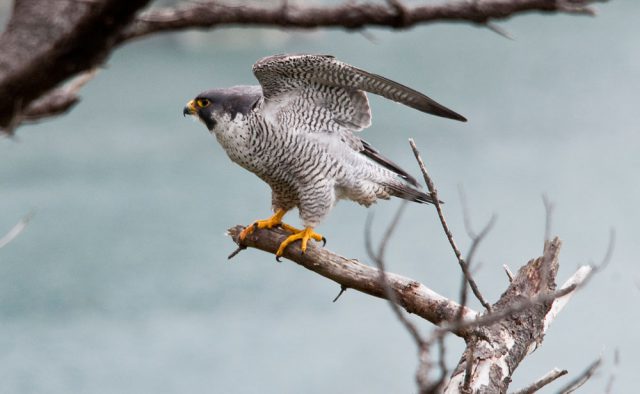Bird Watching on the Oregon Coast
Tillamook County is for the birds!
Between mountain peaks and sandy shores, the Tillamook region has a number of different ecosystems, attracting a variety of bird species. Check out our list for where to find them.
Deep dive into coastal birds
View birds flying over the ocean, sunning themselves on rocks offshore, gliding along open beaches, perched among sand dunes, floating along and hunting in estuaries or hanging out in wetlands and old-growth forests.
Seabirds, waterfowl and sharp-eyed birds of prey all make their homes in our region. Whether they stay for a season or stick around all year, these diverse species are worth seeking out, for visitors and locals alike!
Barview Jetty
Find ocean and bay birds at this rocky jetty leading to the open ocean. Just north of Garibaldi, Cedar Avenue becomes Barview Jetty Park Road. From there, you can turn left onto the short road to the parking lot.
- Black Turnstone
- Common Loon
- Common Murre
- Double-crested and Brandt’s Cormorant
- Pelagic Pigeon Guillemot
- Rock Sandpiper
- Ruddy Turnstone
- Wandering Tattler
- Western Grebe
- Western Gull
Bay City
Spot a variety of birds on the Tillamook Bay. From Oyster Drive off Highway 101, you can often catch a glimpse of shore birds like the spotted sandpiper, and black and ruddy turnstone. In the spring, terns and osprey are common.
- Bald Eagle
- Black Turnstone
- Ruddy Turnstone
- Caspian Tern
- Osprey
- Purple Martin
- Spotted Sandpiper
- Western Gull
Bay City to Tillamook
Along the shores of the Tillamook Bay (near Bay City), through to the rivers and streams that stretch out from the Bay to the Tillamook city limits, you’ll find plenty of interesting birds.
- American Widgeon
- Bald Eagle
- Blue-winged Teal
- Brant
- Canada Geese
- Great Blue Heron
- Green Heron
- Horned Grebe
- Northern Pintail
- Peregrine Falcon
- Red Phalarope
- Snowy Egret
- Tundra Swan
- White-tailed Kite
Cape Lookout State Park
On a sand spit between Netarts Bay and the ocean, get a fine view of the water, surrounding cliffs and lots of feathered friends. You can stop at this prime bird-watching spot while you’re driving the beautiful Three Capes Scenic Loop.
- Brown Creeper
- Cedar Waxing
- Golden-crowned Sparrow
- Gray Jay
- Hairy Woodpecker
- Red Crossbill
- Red-breasted Nuthatch
- White-crowned Sparrow
- Wilson’s Warbler
Upper Nestucca
Enjoy free entry to the amazing Nestucca Bay National Wildlife Refuge, the only coastal location where Dusky Canada Geese spend winters and home to the world’s entire population of Semidi Islands Aleutian Cackling Geese.
- Common Nighthawk
- Mountain Quail
- Northern Pygmy-Owl
- Northern Saw-whet Owl
- Ruffed Grouse
- Spotted Owl
- Varied Thrush
- Western Bluebird
Whalen Island/Clay Meyers Natural Area
Diverse terrain is a hallmark of this natural area where white sand beaches, mudflats, grasslands, dunes and a towering coastal forest all meet. Take the easy 1.5-mile loop hike and see it all, with opportunities to look for birds along the way.
- Bald Eagle
- Least Sandpiper
- Semipalmated Plover Sanderling
- Western Sandpiper
Cape Meares State Scenic Viewpoint
Don’t miss the national refuge surrounding the iconic lighthouse! In this wooded area and the rocky cliffs it overlooks, you’ll spot lots of birds gliding, nesting and hunting.
- Bald Eagle
- Black Oystercatcher
- Cedar Waxwing
- Common Murre
- Dark-eyed Junco
- Gray Jay
- Pelagic Cormorant
- Pigeon Guillemot
- Varied Thrush
- White-crowned Sparrow

Garibaldi Boat Basin
Walk the public pier or the path leading north along the edge of the bay to see herons, eagles, pelicans and much more.
- American Widgeon
- Bald Eagle
- Brown Pelican
- Bufflehead
- Common Merganser
- Great Blue Heron
- Pigeon Guillemot
- Purple Martin
Munson Creek State Natural Site
The tallest waterfall in the Coastal Range, Munson Creek is worth a visit for the magnificent falls alone. But don’t miss the variety of flora and fauna: the creek is an important salmon breeding ground, the forest is comprised of massive cedars and spruces—and there are birds peeking out from the foliage in every season.
- American Dipper
- Chestnut-backed Chickadee
- Golden-crowned Kinglet
- Hairy Woodpecker
- Swainson’s Thrush
- Varied Thrush
- Western Tanager
- Wilson’s Warbler
- Winter Wren
Nehalem Bay Sewage Ponds
Despite a less-than-appealing name, the Sewage Ponds are a wonderful destination for birders. In spring and fall, you’ll find sandpipers along the banks, while birds of prey such as hawks and kites, are here year-round.
- American Widgeon
- Gadwall
- Green-winged Teal
Nehalem Falls Campground
About ten miles east of Nehalem, you’ll find some nice woodsy campsites and trails through old-growth forest. Whether you’re staying overnight or just coming for a day hike, bring binoculars and keep your eyes peeled for a variety of birds!
- American Dipper
- Hermit Warbler
- Mallard
- Migrating Dunlin
- Northern Pintail
- Red-tailed Hawk
- Western and Least Sandpiper
- White-tailed Kite
- Wilson’s Snipe
Nehalem Fish Hatchery
While you observe salmon, steelhead and trout in the water, don’t miss the birds of prey, songbirds and wading birds in the area.
- American Dipper
- Hairy Woodpecker
- Hermit Warbler
- Hooded Merganser
Netarts Bay
Adjacent to Cape Lookout State Park, the estuary at Netarts Bay has over 2,000 acres of water at high tide and about 1,500 acres of exposed land at low tide. The water’s ebb and flow makes this location ideal for crustaceans to forage—and attracts the birds that eat them.
- Brown Pelican
- Bufflehead
- Common Goldeneye Surf Scoter
- Common Loon
- Double-crested Cormorant
- Eared Grebe
- Great Blue Heron
- Great Egret
- Horned Grebe
- Osprey
- Pacific Loon
- Pelagic Cormorant
- Red-throated Loon
- Western Grebe
- Yellow-billed Loon
Three Arch Rocks National Wildlife Refuge
The first designated national refuge in the western United States, Three Arch Rocks is an important seabird breeding ground. Just south of Cape Meares and west of Oceanside, find three large rocks and six small rocks off the coast, home to 200,000 birds.
- Brown Pelican
- Common Loon
- Cormorants
- Surf Scoter
- Western Gull
- Western Red-necked Grebe
